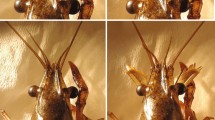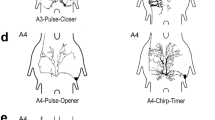Summary
-
1.
Wind directed at the cerci of tethered (Fig. 1 A) or dissected (Fig. 1B) locusts initiates rhythmical activity in elevator and depressor flight muscles.
-
2.
Electrical stimulation of the cercal nerve (200 Hz) also evokes flight motor activity which then continues in the absence of further stimulation (Fig. 2A). Rhythmical activity in DL (depressor) flight muscles begins 168.2±21.4 ms (mean±s.d.) after cercal stimulation. Wind directed at the cerci during such activity increases the frequency of rhythmical bursts in DL motor neurones (Fig. 2B), and reinitiates rhythmical activity in flight interneurones and muscles following a previous flight sequence (Fig. 2C).
-
3.
Depolarizing current injected into either GIN 2 or 4 in the terminal ganglion evokes rhythmical activity in thoracic flight muscles (Fig. 3). This evoked activity begins during the current pulse but only rarely continues beyond the termination of current injection.
-
4.
The rhythmical depolarizations in an elevator flight interneurone (301) are identical in shape whether evoked by wind on the head (Fig. 4A) or wind stimulation of the cerci (Fig. 4 B). Both pathways activate the same thoracic oscillator. The membrane potential of one of the 4 GINs in the terminal ganglion (GIN 2) also oscillates during flight motor activity (Fig. 5A). The oscillations remain as tightly in antiphase to the activity of depressor flight muscles as those in a thoracic interneurone of the central flight oscillator (Fig. 5 B, C).
-
5.
Wind and electrical stimulation of the cerci evoke EPSPs, IPSPs, or both, in a number of thoracic interneurones and motor neurones (Figs. 6, 7; Table 1). In some neurones both the polarity and latency of responses depend on which cercus is stimulated. A group of thoracic interneurones and one motor neurone respond with a latency sufficiently short so as to suggest a direct input from cercal GINs (Fig. 8).
-
6.
Simultaneous intracellular penetrations of cercal GINs and interneurones of the flight motor pathway demonstrate short latency connections between GIN 1 and FIN 302 (dep), GIN 1 and FIN 301 (ele), GIN 4 and FIN 710 (ele), GIN 4 and FIN 320 (ele) (Figs. 9, 10, 11).
-
7.
In the jump motor pathway, four cercal interneurones are found to evoke EPSPs in thoracic premotor interneurone 714 (Fig. 12). These EPSPs could then be identified in an actual response of neurone 714 to cercal stimulation (Fig. 13). Interneurone 714 in turn makes an excitatory connection with the FETi jump motor neurone in the metathoracic ganglion (Fig. 14).
-
8.
The connectivities established between cercal GINs and neurones of thoracic flight (Fig. 15), and jump (Fig. 16), motor pathways are summarized.
Similar content being viewed by others
Abbreviations
- ANT :
-
anterior
- CN :
-
cercal nerve
- CNS :
-
central nervous system
- DL :
-
dorsal longitudinal flight muscle or flight motor neurone
- EMG :
-
electromyogram
- EPSP :
-
excitatory postsynaptic potential
- FETi :
-
fast extensor tibiae motoneurone
- FIN :
-
flight interneurone
- FMN :
-
flight motor neurone
- GIN :
-
giant interneurone
- IN :
-
non-flight interneurone
- IPSP :
-
inhibitory postsynaptic potential
- TG :
-
terminal ganglion
References
Altman J (1983) Sensory inputs and the generation of the locust flight motor pattern: from the past to the future. In: Nachtigall W (ed) Biona Report 2. Gustav Fischer, Stuttgart, pp 127–136
Bacon J, Tyrer M (1979) Wind interneurone input to flight motor neurones in the locust,Schistocerca gregaria. Naturwissenschaften 66:116
Baronetsky E, Möhl B (1987) Afferent input from the cerci on the locust flight motor. In: Elsner N, Creutzfeldt O (eds) New frontiers in brain research — Proc 15th Göttingen Neurobiology Conference. Georg Thieme, Stuttgart New York, p 50
Boyan GS (1985a) Auditory input to the flight system of the locust. J Comp Physiol A 156:79–91
Boyan GS (1985b) Responses to sound of identified neurons in the flight system of the locust (Locusta migratoria). In: Kalmring K, Elsner N (eds) Acoustic and vibrational communication in insects. Paul Parey, Berlin Hamburg, pp 81–88
Boyan GS (1988) Presynaptic inhibition of identified wind-sensitive afferents in the cercal system of the locust. J Neurosci 8:2748–2757
Boyan GS, Ball EE (1989a) Parallel inputs shape the response of a giant interneurone in the cercal system of the locust. J Insect Physiol 35:305–312
Boyan GS, Ball EE (1989b) The wind-sensitive cercal receptor/giant interneurone system of the locust,Locusta migratoria. II. Physiology of giant interneurones. J Comp Physiol A 165:511–521
Boyan GS, Ashman S, Ball EE (1986) Initiation and modulation of flight by a single giant interneuron in the cercal system of the locust. Naturwissenschaften 73:272–274
Boyan GS, Williams JLD, Ball EE (1989a) The wind-sensitive cercal receptor/giant interneurone system of the locust,Locusta migratoria. I. Anatomy of the system. J Comp Physiol A 165:495–510
Boyan GS, Williams JLD, Ball EE (1989b) The wind-sensitive cercal receptor/giant interneurone system of the locust,Locusta migratoria. IV. The non-giant interneurones. J Comp Physiol A 165:539–552
Burrows M (1975) Monosynaptic connexions between wing stretch receptors and flight motoneurones of the locust. J Exp Biol 62:189–219
Camhi JM (1971) Flight orientation in locusts. Sci Am 225:74–81
Camhi J, Hinkle M (1974) Response modification by the central flight oscillator of locusts. J Exp Biol 60:477–492
Dagan D, Parnas I (1970) Giant fibre and small fibre pathways involved in the evasive response of the cockroach,Periplaneta americana. Exp Biol 52:313–324
Fraser P (1977) Cercal ablation modifies tethered flight behaviour of cockroach. Nature 268:523–524
Hedwig B, Pearson KG (1984) Patterns of synaptic input to identified flight motorneurons in the locust. J Comp Physiol A 154:745–760
Hoyle G (1958) The leap of the grasshopper. Sci Am 198:30–35
Kalmring K (1975) The afferent auditory pathway in the ventral cord ofLocusta migratoria (Acrididae). I. Synaptic connectivity and information processing among the auditory neurons of the ventral cord. J Comp Physiol 104:103–141
McCrohan CR (1984) Initiation of feeding motor output by an identified interneurone in the snailLymnaea stagnalis. J Exp Biol 113:351–366
Pearson KG, Robertson RM (1981) Interneurons coactivating hindleg flexor and extensor motoneurons in the locust. J Comp Physiol 144:391–400
Pearson KG, Robertson RM (1987) Structure predicts synaptic function of two classes of interneurons in the thoracic ganglia ofLocusta migratoria. Cell Tissue Res 250:105–114
Pearson KG, Gynther IC, Heitler WJ (1986) Coupling of flight initiation to the jump in locusts. J Comp Physiol A 158:81–89
Pearson KG, Heitler WJ, Sleeves JD (1980) Triggering of locust jump by multimodal inhibitory interneurons. J Neurophysiol 43:257–278
Pearson KG, Reye DN, Robertson RM (1983) Phase-dependent influences of wing stretch receptors on flight rhythm in the locust. J Neurophysiol 49:1168–1181
Pearson KG, Reye DN, Parsons DW, Bicker G (1985) Flightinitiating interneurons in the locust. J Neurophysiol 53:910–925
Reichert H, Rowell CHF (1985) Integration of nonphaselocked exteroceptive information in the control of rhythmic flight in the locust. J Neurophysiol 53:1201–1218
Reye DN, Pearson KG (1987) Projections of the wing stretch receptors to central flight neurons in the locust. J Neurosci 7:2476–2487
Reye DN, Pearson KG (1988) Entrainment of the locust central flight oscillator by wing stretch receptor stimulation. J Comp Physiol A 162:77–89
Ritzmann RE, Pollack AJ (1981) Motor responses to paired stimulation of giant interneurons in the cockroachPeriplaneta americana I. The dorsal giant interneurons. J Comp Physiol 143:61–70
Ritzmann RE, Pollack AJ (1986) Identification of thoracic interneurons that mediate giant interneuron-to-motor pathways in the cockroach. J Comp Physiol A 159:639–654
Ritzmann RE, Pollack AJ (1988) Wind-activated thoracic interneurons of the cockroach: II. Patterns of connection from ventral giant interneurons. J Neurobiol 19:589–611
Ritzmann RE, Pollack AJ, Tobias ML (1982) Flight activity mediated by intracellular stimulation of dorsal giant interneurons of the cockroachPeriplaneta americana. J Comp Physiol 147:313–322
Ritzmann RE, Tobias ML, Fourtner CR (1980) Flight activity initiated via giant interneurons of the cockroach: evidence for bifunctional trigger interneurons. Science 210:443–445
Roberts AM, Krasne FB, Hagiwara G, Wine JJ, Kramer AP (1982) Segmental giant: evidence for a driver neuron interposed between command and motor neurons in the crayfish escape system. J Neurophysiol 47:761–781
Robertson RM, Pearson KG (1982) A preparation for the intracellular analysis of neuronal activity during flight in the locust. J Comp Physiol 146:311–320
Robertson RM, Pearson KG (1983) Interneurons in the flight system of the locust: distribution, connections, and resetting properties. J Comp Neurol 215:33–50
Robertson RM, Pearson KG (1985a) Neural circuits in the flight system of the locust. J Neurophysiol 53:110–128
Robertson RM, Pearson KG (1985b) Neural networks controlling locomotion in locusts. In: Selverston AI (ed) Model neural networks and behavior. Plenum, New York, pp 21–35
Simmons P (1980) Connexions between a movement-detecting visual interneurone and flight motorneurones of a locust. J Exp Biol 86:87–97
Tyrer NM, Altman JS (1974) Motor and sensory flight neurones in a locust demonstrated using cobalt chloride. J Comp Neurol 157:117–138
Weeks JC, Kristan WB Jr (1978) Initiation, maintenance and modulation of swimming in the medicinal leech by the activity of a single neurone. J Exp Biol 77:71–88
Weis-Fogh T (1956) Biology and physics of locust flight II. Flight performance of the desert locust (Schistocerca gregaria). Phil Trans R Soc London B 239:459–510
Author information
Authors and Affiliations
Rights and permissions
About this article
Cite this article
Boyan, G.S., Ball, E.E. The wind-sensitive cercal receptor/giant interneurone system of the locust,Locusta migratoria . J. Comp. Physiol. 165, 523–537 (1989). https://doi.org/10.1007/BF00611239
Accepted:
Issue Date:
DOI: https://doi.org/10.1007/BF00611239




